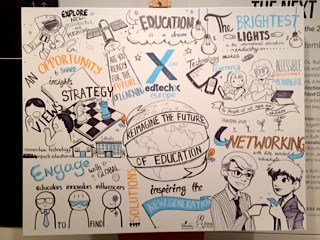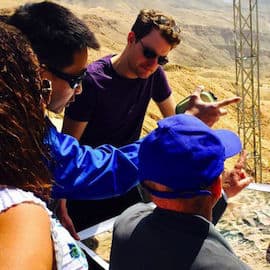EdTech That Can Do Much More for Global Learning
One of the binding factors of our development through enterprise ecommunity is that an innovation made in one part of the world can be seamlessly shared and contextualized for another part of the world. This is usually thought of as North-South technology transfer. But innovations are increasingly happening South-North, and in many diverse aspects that go beyond technology, like innovations in business models, leadership and financing.
This feature of global collaboration and synchrony for greater scale held true at EdTechXEurope 2016, in London earlier this month, where over 800 leaders and shakers in the global education technology space from dozens of countries convened to find better ways to improve access to and quality of education, using technology. EdTechX’s attendance growth of 8x in the past four years attests to a quickly growing and diversifying sector. (Later this year, EdTechX will launchits inaugural EdTechXAsia in Singapore.)
Ed-tech has been hailed as a game-changer of sorts, a movement that will level the playing field for all children. Of course, this sort of hype does not come without drawbacks. More research is showing that technology can only be an enabler and aid – not a replacement – to real, live nurturing teachers in the classroom.
Though classrooms are by far more connected in the developed world, Vineet Bewtra, director of (largely education-related) investments at impact investor Omidyar Network, told attendees that he’s recently observed quite a bit of “reverse tech transfer” from South to North. One of Omidyar’s investments, Geekie in Brazil, recently secured a deal in a major G7 school system, he said. Africa is seeing the launch of its first ed-tech cluster, at the Cape IT Initiative. Ventures like Rekindle Learning and Mwabu are paving the way on the continent.
Harnessing data also became a recurring theme at EdTechX Europe. Jay Kimmelman, CEO of Bridge International Academies in Kenya, talked about being able to collect a “quarter of a million test scores every 10 days” and how this sort of data is the invisible factor revolutionizing the education industry.
According to Rob Grimshaw, the CEO of TES Global, an online teacher network with 8 million education professionals, multiple factors are needed in order for “full digital delivery” to take shape. Those include reliable internet/mobile connectivity and technology, teachers who are well-trained on the technology, high-quality and contextualized content, homework and student assessments that are built into the curriculum experience, and a robust school management system. Currently most schools have a few of the components, but not all of them. He argued ed-tech entrepreneurs need to be cognizant of the whole environment in which they are placing their technologies, for them to be effective.
In a sense, the conference was designed around this notion. Day one consisted only of field trips to education companies like Kano, incubator Emerge Education, University College London’s Knowledge Lab, and others, while day two launched the conference. This enabled participants to see and experience innovation in education as well as make closer connections a day before engaging with the broader concepts and delegates. The relatively smaller size of EdTechX allowed it to experiment with this layout, and may be something other such forums emulate in the future.
EdTechX Europe attracted delegates from every part of the education technology value chain:
- Teacher training organizations like TES Global
- Content players like Bibblio and Bo, a video library for education, which provides content to publishers
- Assessment and homework players like DigiExam and Show My Homework, both of which won the 2016 EdTechX Global All Stars award
- School management systems like another 2016 EdTechX Global All Stars winner, Dheebuk
- Tech providers and platforms, like Netherlands-based Sanoma and IBM Research
- And, of course, education investors like IBIS Capital, Nesta, Omidyar and even the International Finance Corporation
 From the investor perspective, the long sales cycle for education-technology ventures – many of which rely on government and schools district contracts – means ventures need more capital to burn as they build valuable and lucrative relationships, and many want to consider exploring B2C models in the meantime. Bewtra explained, “If you’re a startup in ed-tech, the odds are stacked against you” because the incumbents in the sector hold many of the relationships and power with publishers, governments and other clients. But on the plus side, education is highly valued by households, even if they have low spending power, making the B2C market potentially ripe for a “freemium” model.
From the investor perspective, the long sales cycle for education-technology ventures – many of which rely on government and schools district contracts – means ventures need more capital to burn as they build valuable and lucrative relationships, and many want to consider exploring B2C models in the meantime. Bewtra explained, “If you’re a startup in ed-tech, the odds are stacked against you” because the incumbents in the sector hold many of the relationships and power with publishers, governments and other clients. But on the plus side, education is highly valued by households, even if they have low spending power, making the B2C market potentially ripe for a “freemium” model.
EdTechX Global showcased some the best technologies and innovations in the developed world and middle-income sectors, and began the valuable discussion about ed-tech in emerging markets. The hope is that this aspect of the conversation will grow with EdTechXAsia in November.
Click here to review EdTechX’s 70-page research report on the sector.
Top image: A presentation at EdTechX Europe 2016. Image courtesy of EdTechX.
Homepage image: IICD, via Flickr.
Nilima Achwal is the founder and CEO of Iesha Learning, based in Mumbai, India.
- Categories
- Education
- Tags
- innovation



